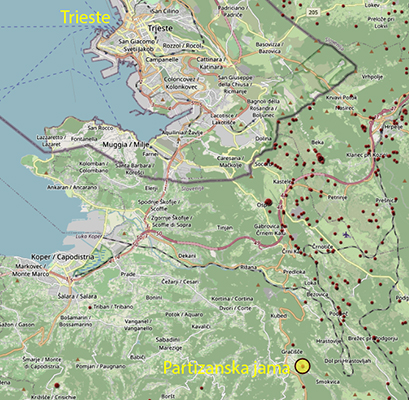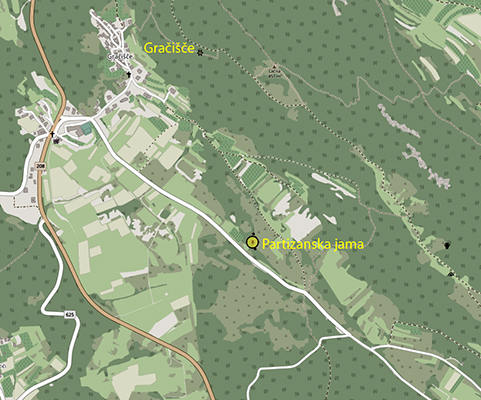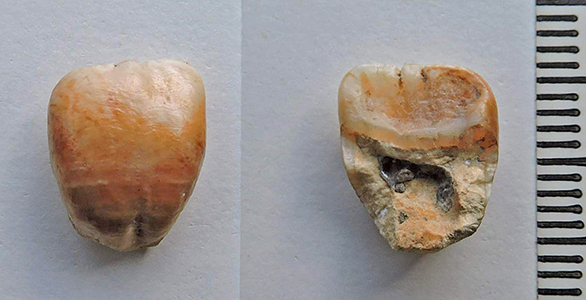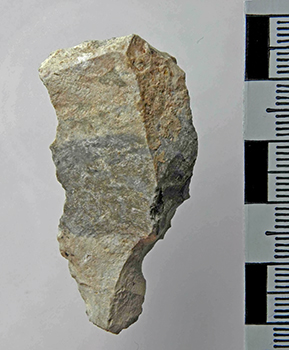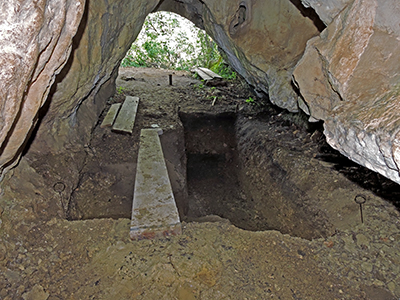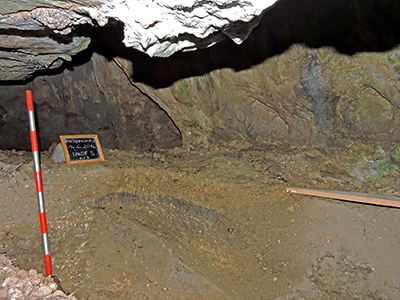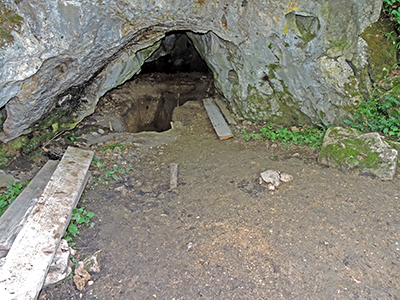Back to Don's Maps
 Back to Archaeological Sites
Back to Archaeological Sites
Partizanska Jama, Partisan Cave in Slovenia
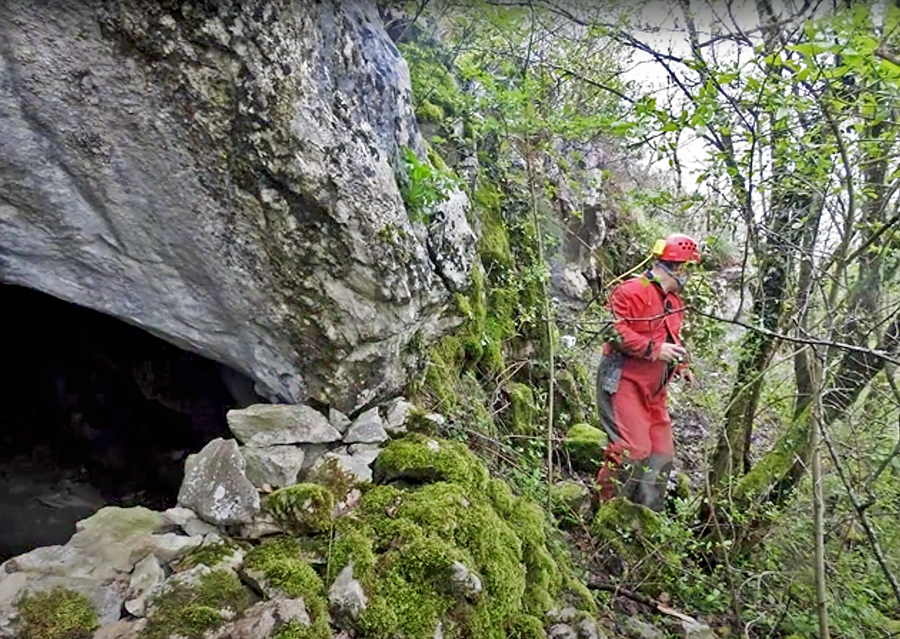
Entrance to one of the caves in the cave complex at Partizanska Jama.
Photo: Anton Della Schiava
Source: https://www.youtube.com/watch?v=hN97W2adUD4&ab_channel=AntonDellaSchiava
( The text, photos and diagrams on this page come from Jamnik et al. (2015) unless otherwise attributed. The following is my brief summary of the paper, which has been meticulously researched and documented - Don )
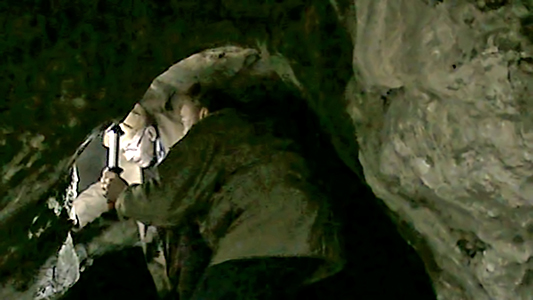
Visit to the cave with Dr Mitja Brodar.
Photo: Jure Jamnik
Source: Jamnik et al. (2015)
Location of the cave, near the village of Gračišče in Slovenia.
Photo: https://www.katasterjam.si/Caves/Details/4771
Plan of the cave.
Photo: Pavel Jamnik
Source: Jamnik P. (pers. comm.)
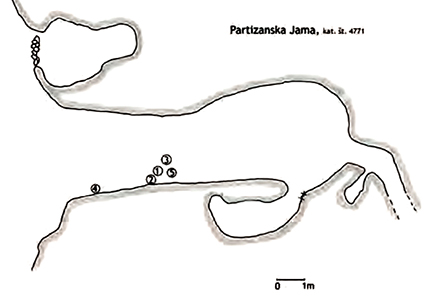
Layout of the entrance to Partizanska jama cave, indicating badger burrows 1-5 and location of bear claw mark (xx).
Sketch: Jure Jamnik
Source: Jamnik et al. (2015)
In this paper we present the finds from the Partisan Cave in Slovenian Istria. Based on a preliminary chemical analysis of the red colour from the cave wall and the exclusion of possible causes, we assume that this is a remnant of the first Palaeolithic cave painting art in Slovenia. The fossil fauna found in layers in badger tunnels is approximately dated. The specimen of the stone tool found in Layer 2 is preliminarily, on the basis of typological properties, attributed to the Middle Palaeolithic. We provide data on the found human incisor, which on the basis of measurement comparisons is assumed to belong to a Neanderthal, which is the first fossil remains of Neanderthal man found in Slovenia. Based on the typology of stone tools, the Plano site under the cave is temporarily placed in the Late Palaeolithic or in the Epigravettian culture.
In January 2008, Pavel Jamnik, a member of the Ribnica Cave Research Society, discovered a trace of a red drawing on the cave wall in Partizanska jama in Slovenian Istria, a remnant of the old cave system, of which only a few smaller cave tunnels remain today.
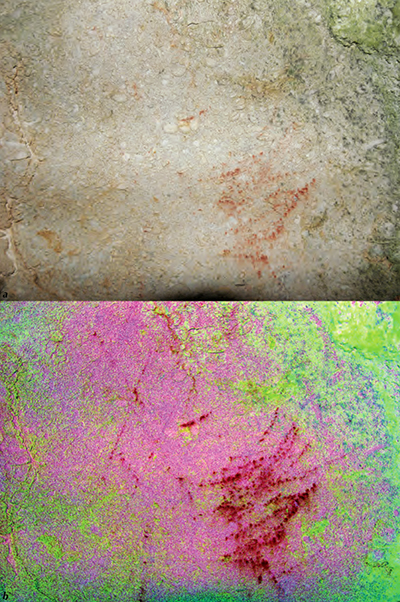
Trace of drawing on the cave wall.
a) original colour
b) enhanced red
Photo: Pavel Jamnik, image processing by Noel Hidalgo Tan
Source: Jamnik et al. (2015)
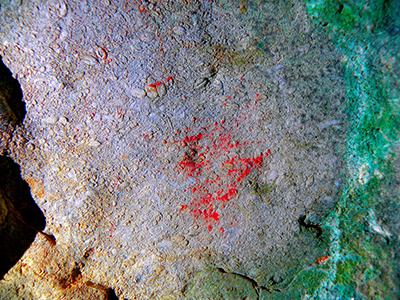
Enhanced version of the red painting.
Photo: Pavel Jamnik, image processing by Noel Hidalgo Tan
Source: Pavel Jamnik, pers.comm.
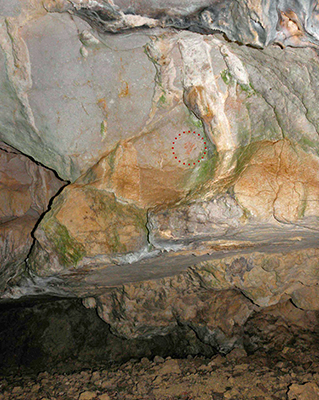
Drawing on the cave wall, in context.
Photo: Pavel Jamnik
Source: Jamnik (2016)
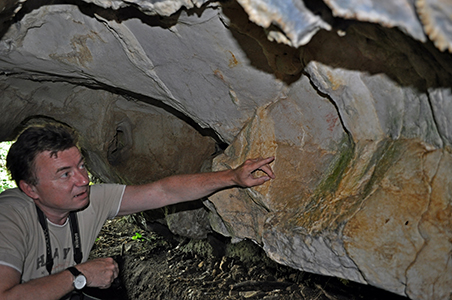
Pavel Jamnik inspecting the red drawing.
Photo: Pavel Jamnik
Source: pers. comm.
After the discovery of material remains of Stone Age culture, the cave was identified as an archaeological site, in accordance with the Cultural Heritage Act.
The cave is a remnant of the former larger cave system, a few metres above the valley level near the hamlet of Gračišče. Sediment fillings and landslides have divided this once unified cave system into several smaller caves.
In the cave with the picture and the small passage next to it, the former height of the currently missing sediments is clearly visible on the cave walls. Sediments are missing mainly in the 9.40 m long entrance tunnel. It seems that there was another cave space or tunnel under today's entrance in the past, but in some period of the cave's history there was a collapse of the ceiling in the lower tunnel and consequently the entrance of the entrance part of today's cave with the painting directly above it. The cave floor settled by 60 to 90 cm. In addition to the traces of the old level of sedimentary filling of the cave on the cave walls, the relatively rapid decrease in sediments is also illustrated by a former stalactite pillar, which hung in the air after the sediments with the lower thickened part. At the end of the approximately 50 m long cave is a small abyss, which in all probability opened at the same time as the landslide, as indicated by the edges of the abyss and the "hanging" tunnel on the opposite side of the abyss.
The cave with the painting and the surrounding caves are today the active dens of many badgers.
On one of the side walls, on the part of the wall that was covered with sediments before the collapse of the floor of the cave, a bear's scratching has been preserved. We believe that the abrasion could have formed only after the sediment was deposited, because if it had been covered with sediments for millennia, it would not have remained so smooth due to corrosion processes between the sediments and the cave wall. The collapse of the ceiling of the lower floor of the tunnel and the consequent subsidence of the cave floor in the upper tunnel must have taken place before the extinction of the cave bear, which made the abrasion. After the intrusion / possession, the cave served at least for some time as a den for the cave bear, which left scrapings on the wall. Sediment intrusion is therefore indirectly dated to the Pleistocene.
Given the still almost sharply demarcated edges between the part of the sediments that settled and the sediments that remained in the original place during the settlement, we estimate that there was no major deposition of new sedimentary fillings after the settlement in the cave with the painting.
Most of the fossil bones and Stone Age cultural remains were in the sediments before the collapse. This means that the collapse at least in the entrance part of the cave affected the preserved stratigraphic sequence of the strata. To date, it has not been possible to assess the extent to which the strata are mixed and the impact of the intrusion / possession on the movement of Pleistocene bone and culture remains.
A painting or remnant of a former painting is located in a small wall-mounted recess. It is 660 cm high from the entrance to the cave, which is today 2 m high and 3.4 m wide, and is 1.2 m above today's cave floor. The height of the tunnel at the place where the painting is today is about 1.6 m. The painting was made in a well-chosen place, as the surrounding part of the cave wall is exposed to moisture and running water on the wall, while the area with the painting is completely dry. The painting is about 10 x 9 cm in size. The red colour can be seen on the wall with the naked eye, but it is not pronounced (Figure 2), so we used the computer program to emphasise the red colour in the photographs. Photographs showed that traces of red colour could be seen in a few places around the preserved paint (Figure 2 / a).
We estimate that the original painting was at least 20 × 20 cm in size, but part of the paint eventually faded or disappeared due to the climatic conditions in the cave. The lines in the picture are not straight, but curved and bent, which is why we believe that the picture represented a figure.
For the time being, we can only say that the preserved part of the picture might illustrate a part of the muzzle of an animal or a snake's head. Figure 2 / c). These marks are significantly different from scratches and lines in different parts of the cave, especially on the larger stalactite in the continuation of the cave, which were caused by the scratching of animals. For the time being, however, it is not possible to talk about the simultaneous formation of incisions and painting on the cave wall.
In our case, we were aware from the very beginning that the lines could also be made, for example, with a piece of natural reddish clayey concretions, which could be seen in the badger's excavated material. In this case, regardless of the time of the painting, it would not be possible to speak of a painting for which a purpose-made pigment was used. Only after performing chemical analyzes of various comparative material would we get a preliminary answer as to whether the assumption of Stone Age painting is justified at all. Until then, we are only dealing with indefinable red lines on the cave wall, which do not mean anything in terms of the archaeological site. Methodologically, such a comparison seemed quite simple, but the implementation showed that chemical analyses and comparisons do not provide unambiguous answers.
When visiting the cave with Dr. Brodarjem we took a sample which contained particles of paint and particles of base rock. The chemical analysis of the sample was performed at the National Forensic Laboratory of the Ministry of the Interior of the Republic of Slovenia. The results and explanations are summarised from the reports of 6 November 2008 and 17 February 2009.
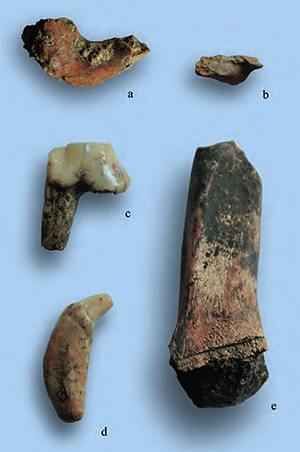
A selection of finds of large mammals
a) mandible of the Alpine marmot; fragment (Marmota marmota; Lair 1);
b) mandible of the gilt-head bream; fragment (Sparus aurata; Lair 2);
c) third lower premolar of the cave hyena; fragment (Crocuta crocuta spelaea; Lair 3);
d) third upper incisive of the cave hyena (Crocuta crocuta crocuta; small hollow);
e) - femur of the wild boar; fragment (Sus cf. scrofa; fissure in the cave wall).
Photo: Tin Valoh
Source:
Jamnik et al. (2015)
Neanderthal upper left incisor.
In the profile of the lair 1, a dental crown of the human upper left incisor was found in the layer, which is referred to as layer 2, at a depth of 43 cm below the present-day walking surface of the cave floor. By comparing the measured values, we first tried to determine possible measurement and design differences with respect to the four upper incisors of modern humans.
The dental crown is labially well preserved, palatally broken in the area of the tubera, or has not yet developed at all due to premature death. The dentin is exposed. There are vertical grooves in the enamel. The shape properties of the tooth root cannot be assessed because the root is missing due to a fracture. The labial surface is concave in the middle and cervical third, with two incisions or fissures in the middle in the mesio-distal direction of the incisal edge, running from the labial surface 0.8 mm through the incisal edge to the palatal surface 2 mm.
On X-ray, the enamel looks radiopaque, the dentin is greyish, the pulpal cavity is almost black. The course of the enamel-cement boundary is also visible macroscopically. The height of the mesial and distal arches cannot be determined due to a fracture. The dental crown is brownish in colour. Dental plaque on the crown part of the tooth is not present.
The age of the specimen at death is difficult to determine definitively.
Photo: Pavel Jamnik
Source: Jamnik et al. (2015)
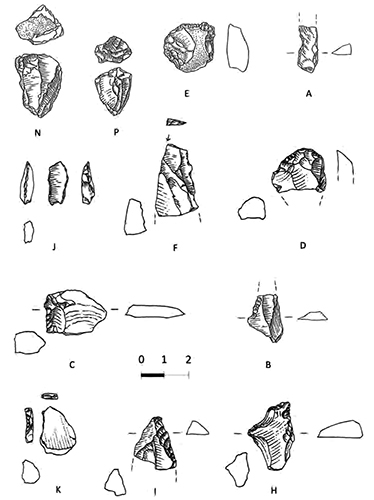
Unipolar core (N, P), end-scraper on flake (E, D), notched bladelet (A, B), backed bladelet (J), burin on oblique truncation (F), raclette (C), backed bladelets and truncation (K), blade with one continuously retouched edge (I), multiple borer (H).
At the bottom of the valley, west below the entrance to the cave, are some areas cultivated for agriculture. During the visits to the cave, we carried out some field inspections of the fields in the autumn and early spring.
At the edge of the valley floor, we found 103 specimens of various elements of the stone industry from quality fine-grained chert (roženca) of various colours (among them one made of rock crystal, quartz) in the part of the field (area approx. 30 × 35 m) that lies closest to the cave. With a few flakes, on the basis of the preserved cortex, it can be established that the material originates at least in part from pebbles.
These are mainly remnants of a distinct microlithic industry (the size of the largest flake is only 28 mm). Two typical Late Palaeolithic unipolar nuclei with negatives of previous flakes stand out (N, P). Ten specimens (which is 9.7% of the total) could be defined as reliably Palaeolithic.
Photo: Sketches by Marko Zorović, image processing by Sanja Djokić.
Source: Jamnik et al. (2015)
Conclusion
When the red lines on the cave wall were discovered, the idea that this could be the first discovered Stone Age cave painting art in Slovenia was so daring that we undertook chemical analyses. The results confirm that it was painted on the cave wall with a purpose-made colour pigment, and exclude the possibility of drawing on the cave wall with clay or pottery from the cave, with a piece of brick or modern acrylic paint. It has not yet been unequivocally confirmed that we are dealing with the remnants of Palaeolithic cave painting, as paintings could also have been created in the younger periods of prehistory, after the Stone Age. An essential argument, however, which speaks in favour of Palaeolithic art, is that so far no younger archaeological remains have been discovered in the cave or in the immediate vicinity, which would immediately call into question the assessment of the painting. Therefore, the rest of the paint on the cave wall is at least preliminarily attributed to Palaeolithic painters.
By sampling and sieving, albeit only a few kilograms of layers from narrow badger holes, and on the basis of finding undoubted Stone Age remains and a human tooth, we can already preliminarily indicate where at least one Stone Age cultural layer is present in cave sediments. Since fragments of fossil bones already appear in layer 1 and two fragments of modern pottery were also found in layer 2, where Pleistocene fauna and remnants of the stone industry predominate, it is clear that the layers are at least partially mixed. Visually, the difference between the compactness, colour and composition of layers 1 and 2 can be seen in general, so that the relocation of cultural remains was most likely due to repeated badger burials over the millenia and subsequent scattering of higher layers deeper into the holes. Based on the available data, it is impossible to say whether the mixing was also influenced by landslides or sedimentation. Only archaeological excavations could offer an answer to this question. The results of radiocarbon analysis of charcoal are also in line with the findings on layer mixing.
However, based on the projection of ecological tolerances of today's populations of individual animal species on the same populations from previous periods, we can assume that the analysed residues are most likely not completely simultaneous. Of course, it should be borne in mind that mammals are able to adapt to different environments and have thus been able to inhabit different habitats in the past than those in which they live today.
Blade with abrupt truncation and faceted platforms.
Sketches: drawn by Marko Zorović, image processing by Sanja Djokić.
Source: Jamnik et al. (2015)
Photo: Pavel Jamnik
Source: pers. comm.
The discovery of a tool (above) with a convex transverse retouch and faceted platforms, and the discovery of a human tooth, coincide in time. Based on typological characteristics, the tool is placed in the Mousterian culture, i.e. Neanderthal. Based on measurement and shape characteristics, The tooth found in the same layer is also of a Neanderthal.
The majority of this layer contains identifiable fossil fauna. The fossil fauna found does not contradict the contemporaneity with Neanderthal culture. A direct link between cave painting and Neanderthal culture cannot yet be confirmed, but it is not ruled out. Since there is a possibility that part of the fauna is from the late glacial, in this case it could be contemporaneous with the planned site under the cave, which is placed in the Late Palaeolithic or epigravettian culture. The cave and the plain site are so close that there can be no doubt at all that the people whose material remains we found on the arable land also visited the cave.
The painting on the cave wall during the Stone Age could be made either by Neanderthals, whose material and osteological remains were found in the cave, or by Epigravettian people from the site below the cave, who probably visited the cave for tens of thousands of years after the Neanderthals. The incisions at the entrance to the cave are undoubtedly old, given the already partially corroded edges of the incisions. There is no point of reference on the basis of which they could be connected with the finds in the cave or under the cave. Nevertheless, these incisions also require serious consideration, as they are very similar to the finds in Gorham Cave in Gibraltar, which the authors attribute to the Neanderthal (Vidal et al. 2014).
Despite the performed analyses and comparisons, there is still not enough material available to be able to exclude the possibility of the formation of the painting in younger prehistoric periods. It is also true, however, that we have nothing to suggest that the painting is younger than the Palaeolithic. More about this source textSource text required for additional translation information In 2008, a trace of red drawing was found on the rock surface of the Partizanska jama cave in Slovene Istria. A preliminary chemical analysis of the red pigment and of the comparative material has been conducted. The results confirmed that the image on the cave wall had been drawn with a specifically crafted colour pigment which was essentially based on iron oxide.
Recovered from badger burrows and from a few kilos of wet-sieved sediment from two layers (max. depth 65 cm) were Pleistocene fauna remains Amid the remains a Mediterranean/Blind mole (Talpa caeca) was found, the first of its kind ever uncovered in Pleistocene sediments in Slovenia. Also found were a blade with an abrupt truncation with faceted platforms (Fig. 4) and a human tooth (Fig. 8, 9).
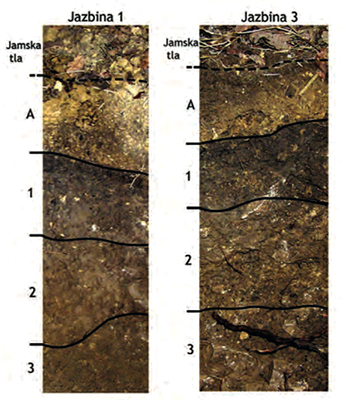
Sedimental layers in badger burrows 1 and 3.
Photo: Pavel Jamnik
Source: Jamnik et al. (2015)
Because of the collapse of the cave floor, and subsequent sinking of sediments, and considering that layers have been turned over and over for centuries by the digging of badgers, it is currently not possible to establish - at least in the absence of proper archaeological excavation - any exact chronological relations between individual animal species found or correlations between the archaeological finds and the sediment sequence in the cave. Relying on its typological features, the blade can already be identified as belonging to Mousterian cultures.
Based on the metric and shape-related considerations, the human tooth, i.e. the crown of a maxillary left incisor (I1), is believed to have belonged to a Neanderthal. This find has been reported reported as the first Neanderthal osteal fossil uncovered in Slovenia. The faunistic finds do not contradict such chronological classification.
On a cultivated field in front of the cave entrance, 103 diverse examples related to stone industry made of high-quality fine-grained chert of different colours were collected. The finds are typical representatives of microlith industry. Ten artefacts were typologically classifiable (T1) and temporarily ascribed to the Upper Palaeolithic or the Epigravettian cultures. The drawing on the cave wall may have been produced either during the stone age by Neanderthal inhabitants whose material and osteal remains were discovered inside the cave or, perhaps, by Epigravettian people who definitely visited the cave, yet tens of thousands of years later.
Thus far, our research has not yielded sufficient evidence to disprove entirely that cave paintings were produced later, i.e. in more recent prehistoric periods. Importantly, no material remains more recent than Palaeolithic have been found in the cave or in front of it. The results and comparative chemical analyses may possibly indicate a chronological connection between the cave painting and the Palaeolithic material remains.
In the summer of 2016, further excavations were carried out by the Slovenian Archaeological Institute. The findings are not published yet, but there were two more Neanderthal teeth, some artefacts and various fauna found.
Photo and text: Pavel Jamnik
Source: pers. comm.
References
- Jamnik P., Veluŝĉek A., Josipoviĉ Ĉelesnik R., Toŝkan B., 2015: Partizanska jama in plano najdišče pod jamo - novi paleolitski lokaciji v slovenski Istri, Annales. Series historia et sociologia, letnik 25. številka 4 (2015) str. 705-732.
- Jamnik P., 2016: Najdba_domnevne_prve_sledi_paleolitskega_JAMSKEGA_SLIKARSTVA_in_prvega_fosilnega_ostanka_NEANDERTALCA_V_SLOVENIJI_SLO_časi_kraji_ljudje_September_2016 (PDF) Najdba domnevne prve sledi paleolitskega JAMSKEGA SLIKARSTVA in prvega fosilnega ostanka NEANDERTALCA V SLOVENIJI. SLO č...
Back to Don's Maps
 Back to Archaeological Sites
Back to Archaeological Sites
